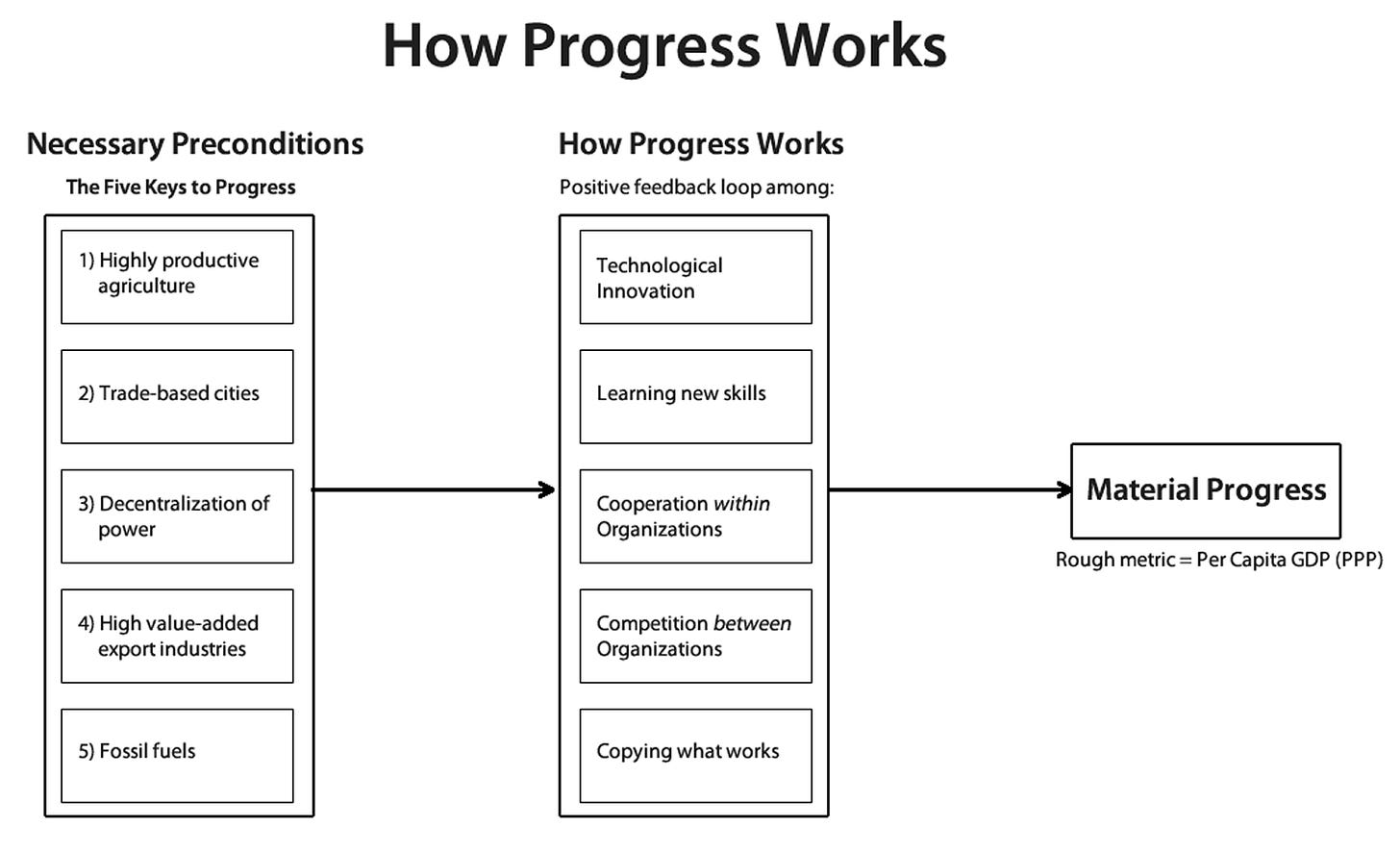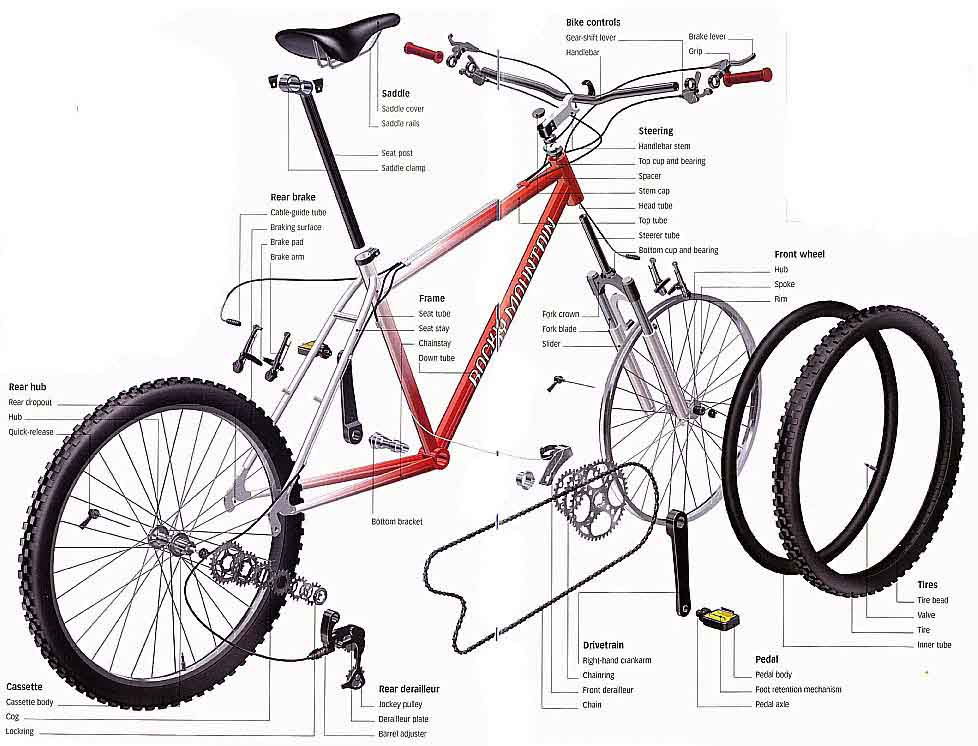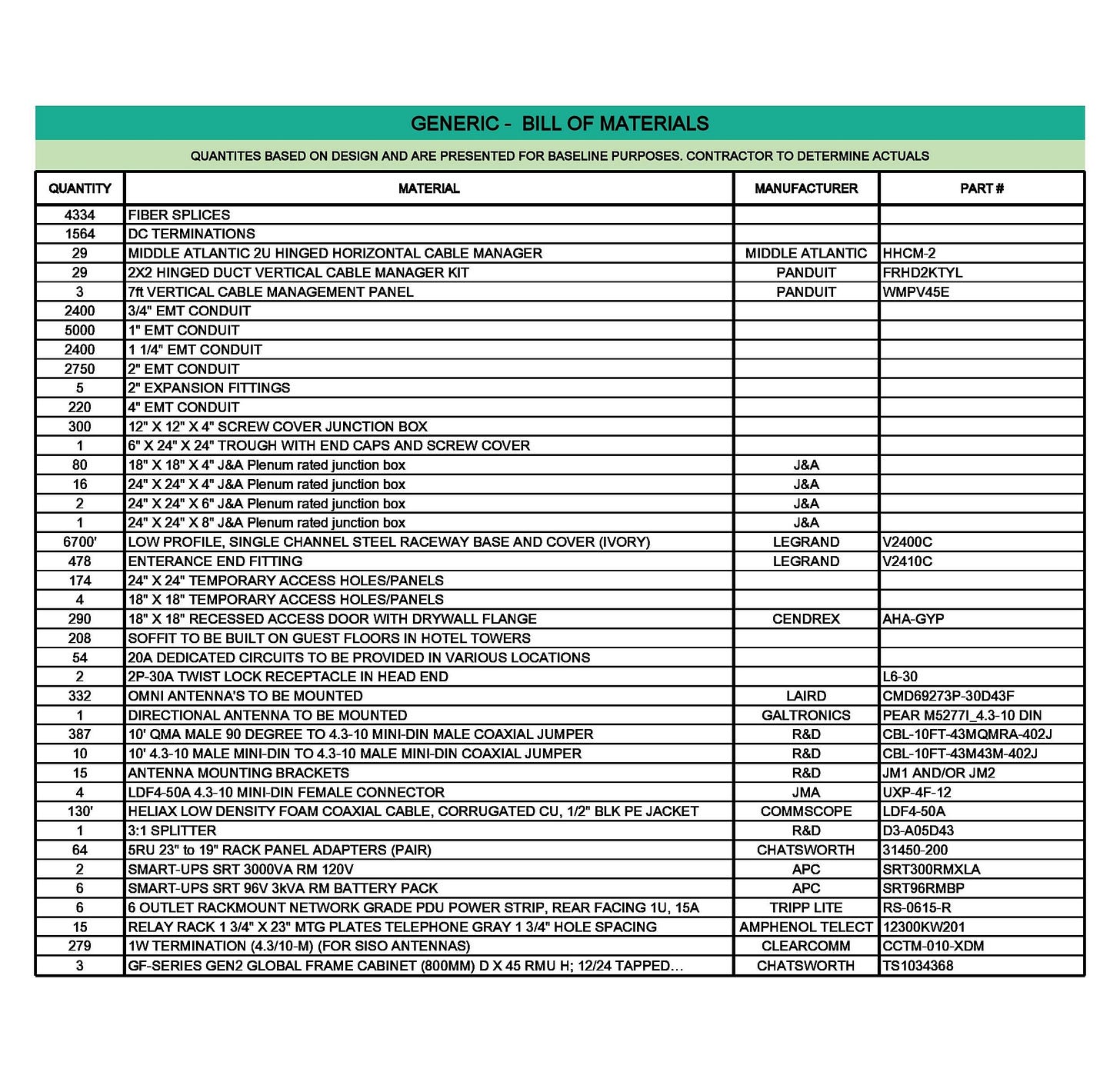Understanding Technological Innovation
Technological innovation consists of combining simple technologies to create a more complex and more useful technology.
Make someone’s day: Gift a subscription to your friends and family!
In a previous excerpt from my book, I made the case that we can best understand the nature of human material process using the concept of the Five Keys to Progress. The Five Keys to Progress provide the essential preconditions for creating and sustaining the vast, decentralized problem-solving network that generates progress.
The question naturally arises: how does this vast, decentralized problem-solving network function? What are the principle mechanics that enable this network to deliver progress both today and in the past?
In this and the follow excerpts, I will explain in more detail how progress works. I will focus on the lower-level mechanics of that vast, decentralized problem-solving network. A good way to think of it is that once the Five Keys to Progress create a critical mass for preconditions for the network to emerge, these lower-level factors are what enables the network to produce progress.
Under the right conditions (i.e. when the Five Keys to Progress are establish), societies become a vast decentralized problem-solving network that generates progress. The single most important factor in this problem-solving network generates progress is:
Technological innovation. This includes radical innovations such as the railroad, electrical grid, computers and the internet, as well as the ongoing incremental improvement and differentiation of thousands of other existing technologies.
See also my other articles on Technology and Innovation:
Understanding Technological Innovation (this article)
Book review: "The Nature of Technology: What It Is and How It Evolves" by W. Brian Arthur (podcast)
The following is an excerpt from my book From Poverty to Progress: Understanding Humanity’s Greatest Achievement. You can purchase discounted copies of my book at my website, or pay full prize at Amazon.
Other books in my “From Poverty to Progress” book series:
Technologies Are Modular
As W. Brian Arthur points out in The Nature of Technology, (summary here) all but the simplest technologies are combinations of less complex technologies. Take a bicycle, for example. A bicycle consists of many components: two wheels, a frame, the transmission, braking system and saddle.
Many of these components can be broken down further into sub-components. The transmission component consists of a number of sub-components: pedal, crank arm, chainrings, cassette, front and back derailleurs, chain and shifters. The cassette sub-component consists of an assembly of many gears.
The bicycle is a technology, but so are each of its components, as well as all of its sub-components and assemblies. Highly modified versions of these components are used in other forms of transportation technologies, such as motorcycles or dirt bikes. Slightly modified versions of these components are used in other types of bikes, such as commuter bikes, e-bikes, road bikes or mountain bikes.
Each of those bikes is related to each other because they have similar component technologies. But each uses different versions of those components to be more effective in solving different problems in different environments.
The motorcycle is more effective at carrying one person at speed on a paved road. The dirt bike is more effective at carrying one person at speed across a broken landscape. The mountain bike is more effective at giving one person aerobic exercise on unpaved surfaces. The road bike is more effective at giving one person aerobic exercise on paved roads.
Motorcycles and dirt bikes are very different from other bicycles because they have internal combustion engines. But internal combustion engines are components of a vast number of different transportation technologies: automobiles, trucks, railroads, and ships.
And the internal combustion engines themselves have a vast number of parts. Each type of engine has slightly different implementations of these parts to function optimally within that transportation device. Until one reaches the base materials that humans extract from nature, every technology is composed of other technologies.
The bicycle is an example of a synergy because the whole bicycle is fundamentally different from the sum of its parts. More importantly for humans, bicycles are useful pieces of technology – far more useful than each of its parts when separated. If one part of the bicycle falls off, it is suddenly less useful than it was when it was complete.
If the parts by themselves were more useful than the bicycle, they would never have been assembled in the first place. In addition, the bicycle as a whole can be improved by modifying one or more of its parts, leaving the opportunity for constant, incremental improvement. Smoother shifting transmissions can be created, along with lower resistance tires, more powerful brakes, and a larger number of gears. Steel components can be swapped out in favor of titanium components to save weight.
Bill of Materials
All but the simplest technologies can be broken down similarly. To manage the full complexity of modern technology, industrial companies create a Bill of Materials (BOM) for all of their products. A BOM is a list of materials, sub-assemblies, parts, and quantities that make up the product. Its purpose is to enable people to build, sell, and service products exactly as they were designed.
Because technologies are modular, BOMs represent the product in a hierarchy of discrete parts. The finished product, for example, a bicycle is at the top level. All of its components are on the second level, for example, the wheels or transmission. The sub-components of the bicycle, for example, a cassette are on the third level: and we can continue all the way down to the base materials. For a complex technology, such as a commercial airliner, a BOM may include tens of thousands of components, sub-components, assemblies, sub-assemblies and parts, all the way from the fuselage to a lowly screw.
Bills of Material also define the final product in varying ways depending upon the occupation of the person viewing it. An Engineering BOM describes the final product as it is being designed or redesigned. A Manufacturing BOM describes how the final product is to be built. A Sale BOM describes how the final product is to be ordered from sub-contractors. Finally, a Service BOM describes the final product as it is to be serviced, diagnosed and repaired.
Even with all this complexity, BOMs often underestimate the actual complexity of a piece of technology, as many companies buy assemblies or parts from other companies. Those companies have their own BOMs to describe all the parts needed to manufacture their “final” product.
A “BOM of all BOMs” that describes all the technology currently in existence as well as how to design, manufacture, distribute and service each of them would be of staggering size. Even a BOM for all the technologies of a typical Hunter-Gatherer society would fill an encyclopedia.
Innovation Is Recombinatory
Another observation made by W. Brian Arthur is that every innovation, no matter how different it appears from previous technology, is based on combinations of already-existing technologies. All ideas, no matter how profound, are based upon combining already-existing ideas. To innovate one needs to combine many existing technologies or ideas in a way that solves a problem more effectively. The whole is new, but the parts are copies.
When automotive engineers design a new car, they do not reinvent every part of the car. That would be extremely time-consuming and would sidestep all the learning that took place to optimize those parts by previous engineers.
Instead, engineers decide what problems need to be solved better. It might be the sale price; it might be fuel economy; it might be styling; it might be performance. Then they look for existing technologies that can be swapped out from existing models to solve those problems. It might be changing the tires; it might be adding cylinders to the engine; or it might be swapping out an internal combustion engine for an electric motor.
It is only when automotive engineers believe that they have used all possible existing parts that they experiment with building completely new parts. This is usually because all the other existing parts work perfectly fine, but there is one part that is a weak link. If they can drastically change that one part, then the new model can use the others parts more effectively. With one small change of a part, the new car can solve the chosen problem better.
Automotive engineers might decide to ask their tire sub-contractors to create a prototype for a tire using less sticky rubber. They might decide that building the frame out of aluminum instead of steel will save significant amounts of weight. They might decide to add in self-driving technology that is already being used by drones.
All of those changes can potentially lead to breakthroughs in automotive design. But everyone still recognizes the final result as a car. You can look at a Honda Accord today and a Model T built one century ago and immediately recognize that they are both cars. The Honda Accord is better in virtually every way than the Model T, but they are both still cars.
Honda engineers have achieved this goal by implementing all the design optimizations made for each of thousands of internal parts over a century. And every one of those parts is a copy that is either identical or closely resembles parts used in previous cars.
If one looks at the total amount of innovation in a current-model Honda Accord compared to all other cars, the changes are trivial. The Honda Accord, however, is a very impressive piece of technology because Honda engineers copied the innovations made by previous engineers and only copied those that worked best. Honda itself made some of those innovations in previous models, but other car companies or sub-contractors made the vast majority.
Even the most innovative companies in the world spend far more time copying than innovating. Or more accurately, they innovate by assembling unique combinations of existing technologies. They innovate by copying.
Technology is critical to human material progress, but technology is useless without people with the skills related to that technology. In the next article in this series, I will discuss people learning new skills to support those technologies. Without these skills, technologies are not useful, a fact that is often forgotten.
The above is an excerpt from my book From Poverty to Progress: Understanding Humanity’s Greatest Achievement. You can purchase discounted copies of my book at my website, or pay full prize at Amazon.
Other books in my “From Poverty to Progress” book series:
See also my other articles on Technology and Innovation:
Understanding Technological Innovation (this article)
Book review: "The Nature of Technology: What It Is and How It Evolves" by W. Brian Arthur (podcast)
You can learn more about How Progress Works with these links:
People learning new skills to support those technologies.
Competition between organizations for scarce resources.
People copying successful technologies, skills, and organizations and then modifying them to solve different problems.
Consumption of vast amounts of useful energy.






I love the term "vast decentralized problem solving network." So much of the Progress literature revolves around the idea of collective problem-solving.